Clinical Leadership: Comparing Theories in Nursing Practice
VerifiedAdded on 2022/12/26
|13
|3115
|59
Essay
AI Summary
This essay examines the critical role of clinical leadership in nursing, emphasizing its importance for high-quality healthcare delivery. The essay compares and contrasts two essential leadership theories: transformational and authentic leadership. It delves into the characteristics, historical context, a...

Running Head: CLINICAL LEADERSHIP IN NURSING
CLINICAL LEADERSHIP IN NURSING
Name of the Student
University Name
Author Note
CLINICAL LEADERSHIP IN NURSING
Name of the Student
University Name
Author Note
Paraphrase This Document
Need a fresh take? Get an instant paraphrase of this document with our AI Paraphraser
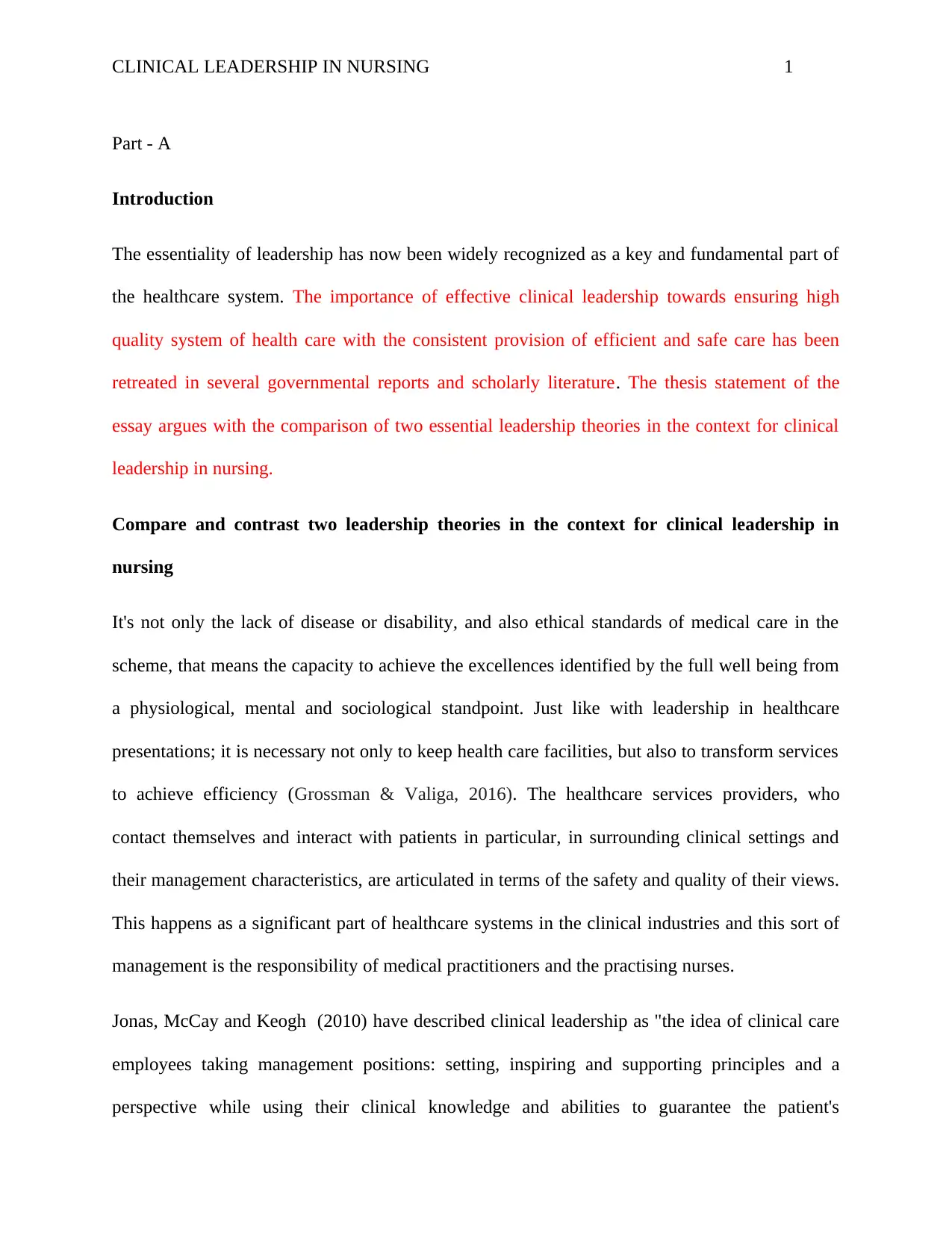
CLINICAL LEADERSHIP IN NURSING 1
Part - A
Introduction
The essentiality of leadership has now been widely recognized as a key and fundamental part of
the healthcare system. The importance of effective clinical leadership towards ensuring high
quality system of health care with the consistent provision of efficient and safe care has been
retreated in several governmental reports and scholarly literature. The thesis statement of the
essay argues with the comparison of two essential leadership theories in the context for clinical
leadership in nursing.
Compare and contrast two leadership theories in the context for clinical leadership in
nursing
It's not only the lack of disease or disability, and also ethical standards of medical care in the
scheme, that means the capacity to achieve the excellences identified by the full well being from
a physiological, mental and sociological standpoint. Just like with leadership in healthcare
presentations; it is necessary not only to keep health care facilities, but also to transform services
to achieve efficiency (Grossman & Valiga, 2016). The healthcare services providers, who
contact themselves and interact with patients in particular, in surrounding clinical settings and
their management characteristics, are articulated in terms of the safety and quality of their views.
This happens as a significant part of healthcare systems in the clinical industries and this sort of
management is the responsibility of medical practitioners and the practising nurses.
Jonas, McCay and Keogh (2010) have described clinical leadership as "the idea of clinical care
employees taking management positions: setting, inspiring and supporting principles and a
perspective while using their clinical knowledge and abilities to guarantee the patient's
Part - A
Introduction
The essentiality of leadership has now been widely recognized as a key and fundamental part of
the healthcare system. The importance of effective clinical leadership towards ensuring high
quality system of health care with the consistent provision of efficient and safe care has been
retreated in several governmental reports and scholarly literature. The thesis statement of the
essay argues with the comparison of two essential leadership theories in the context for clinical
leadership in nursing.
Compare and contrast two leadership theories in the context for clinical leadership in
nursing
It's not only the lack of disease or disability, and also ethical standards of medical care in the
scheme, that means the capacity to achieve the excellences identified by the full well being from
a physiological, mental and sociological standpoint. Just like with leadership in healthcare
presentations; it is necessary not only to keep health care facilities, but also to transform services
to achieve efficiency (Grossman & Valiga, 2016). The healthcare services providers, who
contact themselves and interact with patients in particular, in surrounding clinical settings and
their management characteristics, are articulated in terms of the safety and quality of their views.
This happens as a significant part of healthcare systems in the clinical industries and this sort of
management is the responsibility of medical practitioners and the practising nurses.
Jonas, McCay and Keogh (2010) have described clinical leadership as "the idea of clinical care
employees taking management positions: setting, inspiring and supporting principles and a
perspective while using their clinical knowledge and abilities to guarantee the patient's
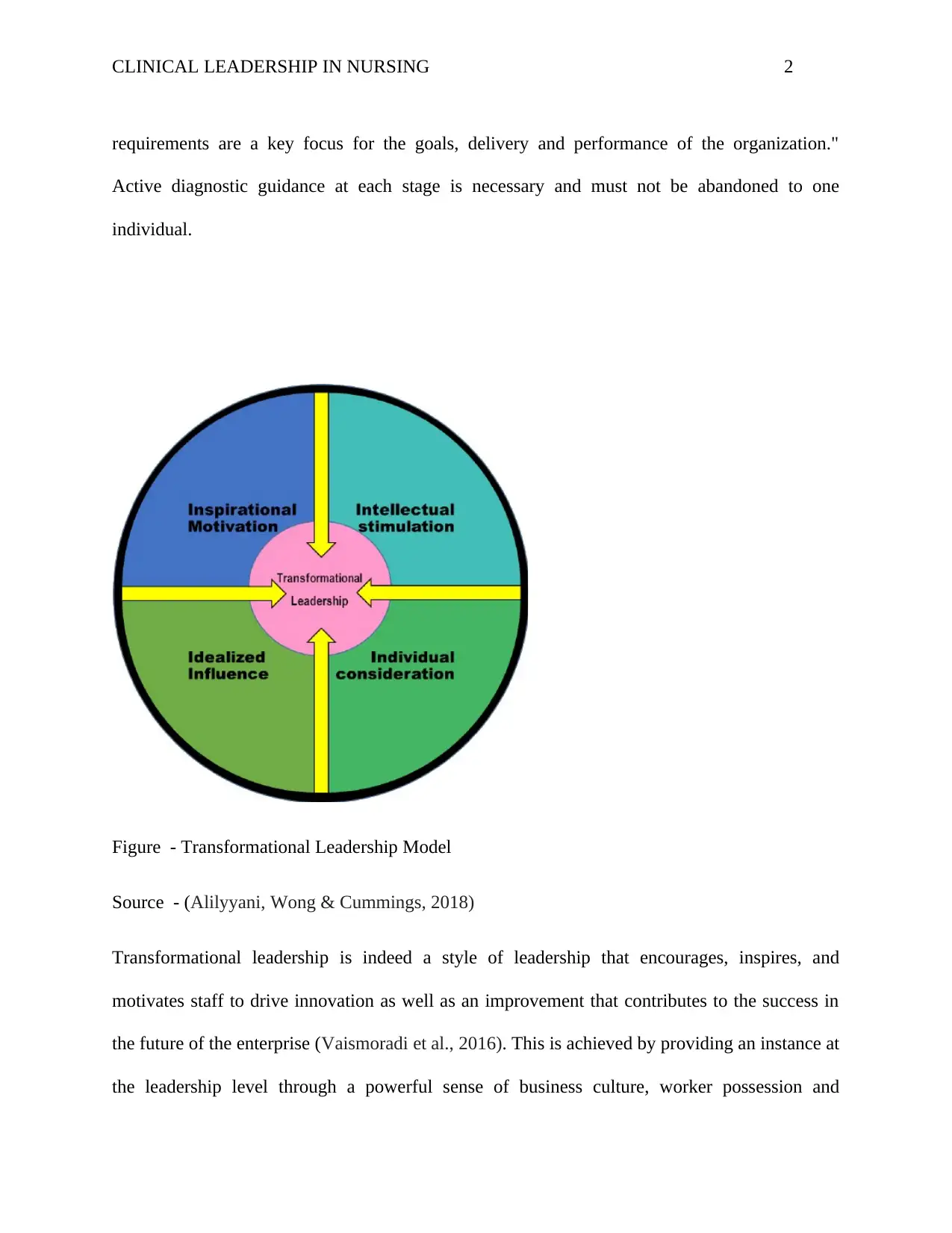
CLINICAL LEADERSHIP IN NURSING 2
requirements are a key focus for the goals, delivery and performance of the organization."
Active diagnostic guidance at each stage is necessary and must not be abandoned to one
individual.
Figure - Transformational Leadership Model
Source - (Alilyyani, Wong & Cummings, 2018)
Transformational leadership is indeed a style of leadership that encourages, inspires, and
motivates staff to drive innovation as well as an improvement that contributes to the success in
the future of the enterprise (Vaismoradi et al., 2016). This is achieved by providing an instance at
the leadership level through a powerful sense of business culture, worker possession and
requirements are a key focus for the goals, delivery and performance of the organization."
Active diagnostic guidance at each stage is necessary and must not be abandoned to one
individual.
Figure - Transformational Leadership Model
Source - (Alilyyani, Wong & Cummings, 2018)
Transformational leadership is indeed a style of leadership that encourages, inspires, and
motivates staff to drive innovation as well as an improvement that contributes to the success in
the future of the enterprise (Vaismoradi et al., 2016). This is achieved by providing an instance at
the leadership level through a powerful sense of business culture, worker possession and
⊘ This is a preview!⊘
Do you want full access?
Subscribe today to unlock all pages.

Trusted by 1+ million students worldwide
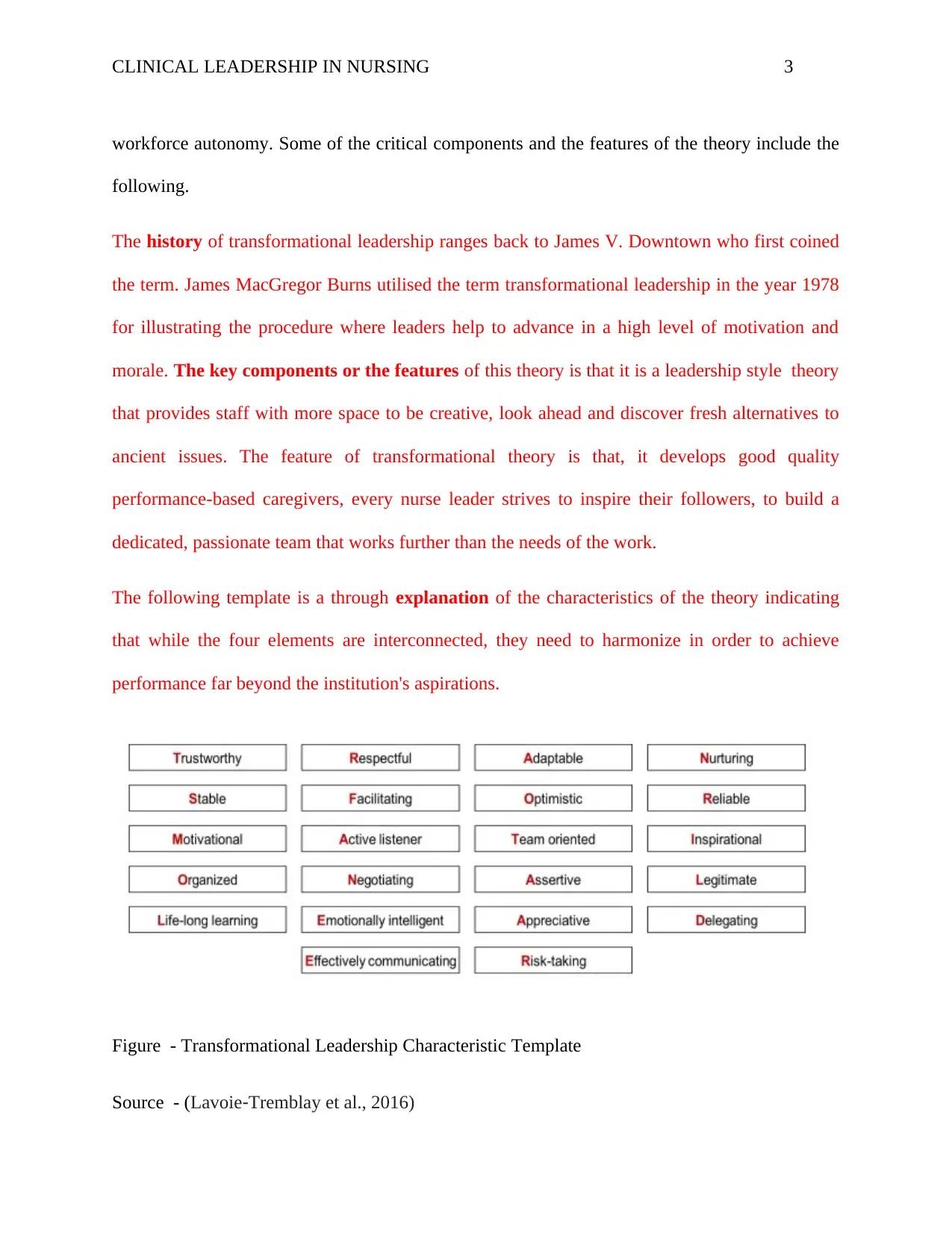
CLINICAL LEADERSHIP IN NURSING 3
workforce autonomy. Some of the critical components and the features of the theory include the
following.
The history of transformational leadership ranges back to James V. Downtown who first coined
the term. James MacGregor Burns utilised the term transformational leadership in the year 1978
for illustrating the procedure where leaders help to advance in a high level of motivation and
morale. The key components or the features of this theory is that it is a leadership style theory
that provides staff with more space to be creative, look ahead and discover fresh alternatives to
ancient issues. The feature of transformational theory is that, it develops good quality
performance-based caregivers, every nurse leader strives to inspire their followers, to build a
dedicated, passionate team that works further than the needs of the work.
The following template is a through explanation of the characteristics of the theory indicating
that while the four elements are interconnected, they need to harmonize in order to achieve
performance far beyond the institution's aspirations.
Figure - Transformational Leadership Characteristic Template
Source - (Lavoie‐Tremblay et al., 2016)
workforce autonomy. Some of the critical components and the features of the theory include the
following.
The history of transformational leadership ranges back to James V. Downtown who first coined
the term. James MacGregor Burns utilised the term transformational leadership in the year 1978
for illustrating the procedure where leaders help to advance in a high level of motivation and
morale. The key components or the features of this theory is that it is a leadership style theory
that provides staff with more space to be creative, look ahead and discover fresh alternatives to
ancient issues. The feature of transformational theory is that, it develops good quality
performance-based caregivers, every nurse leader strives to inspire their followers, to build a
dedicated, passionate team that works further than the needs of the work.
The following template is a through explanation of the characteristics of the theory indicating
that while the four elements are interconnected, they need to harmonize in order to achieve
performance far beyond the institution's aspirations.
Figure - Transformational Leadership Characteristic Template
Source - (Lavoie‐Tremblay et al., 2016)
Paraphrase This Document
Need a fresh take? Get an instant paraphrase of this document with our AI Paraphraser
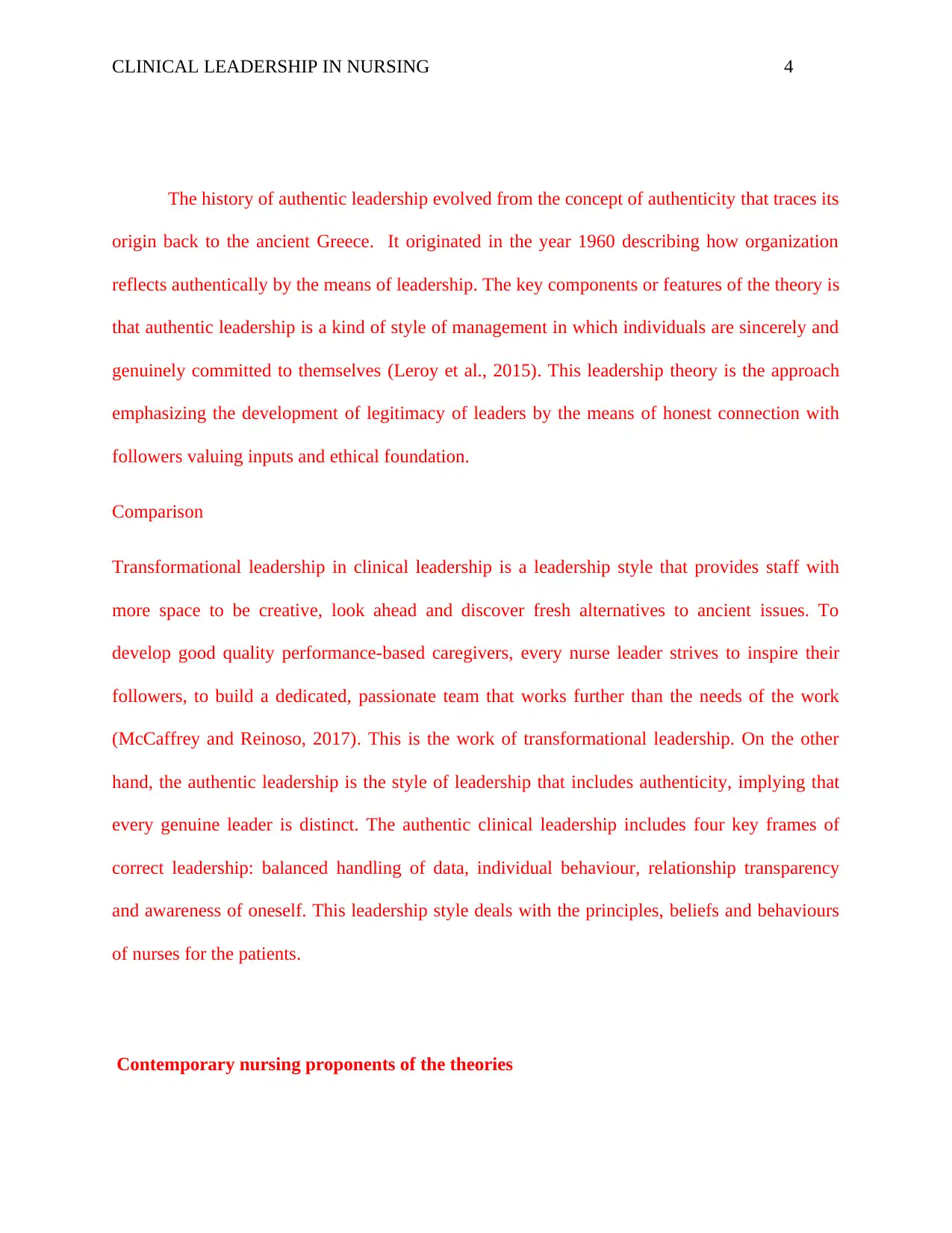
CLINICAL LEADERSHIP IN NURSING 4
The history of authentic leadership evolved from the concept of authenticity that traces its
origin back to the ancient Greece. It originated in the year 1960 describing how organization
reflects authentically by the means of leadership. The key components or features of the theory is
that authentic leadership is a kind of style of management in which individuals are sincerely and
genuinely committed to themselves (Leroy et al., 2015). This leadership theory is the approach
emphasizing the development of legitimacy of leaders by the means of honest connection with
followers valuing inputs and ethical foundation.
Comparison
Transformational leadership in clinical leadership is a leadership style that provides staff with
more space to be creative, look ahead and discover fresh alternatives to ancient issues. To
develop good quality performance-based caregivers, every nurse leader strives to inspire their
followers, to build a dedicated, passionate team that works further than the needs of the work
(McCaffrey and Reinoso, 2017). This is the work of transformational leadership. On the other
hand, the authentic leadership is the style of leadership that includes authenticity, implying that
every genuine leader is distinct. The authentic clinical leadership includes four key frames of
correct leadership: balanced handling of data, individual behaviour, relationship transparency
and awareness of oneself. This leadership style deals with the principles, beliefs and behaviours
of nurses for the patients.
Contemporary nursing proponents of the theories
The history of authentic leadership evolved from the concept of authenticity that traces its
origin back to the ancient Greece. It originated in the year 1960 describing how organization
reflects authentically by the means of leadership. The key components or features of the theory is
that authentic leadership is a kind of style of management in which individuals are sincerely and
genuinely committed to themselves (Leroy et al., 2015). This leadership theory is the approach
emphasizing the development of legitimacy of leaders by the means of honest connection with
followers valuing inputs and ethical foundation.
Comparison
Transformational leadership in clinical leadership is a leadership style that provides staff with
more space to be creative, look ahead and discover fresh alternatives to ancient issues. To
develop good quality performance-based caregivers, every nurse leader strives to inspire their
followers, to build a dedicated, passionate team that works further than the needs of the work
(McCaffrey and Reinoso, 2017). This is the work of transformational leadership. On the other
hand, the authentic leadership is the style of leadership that includes authenticity, implying that
every genuine leader is distinct. The authentic clinical leadership includes four key frames of
correct leadership: balanced handling of data, individual behaviour, relationship transparency
and awareness of oneself. This leadership style deals with the principles, beliefs and behaviours
of nurses for the patients.
Contemporary nursing proponents of the theories
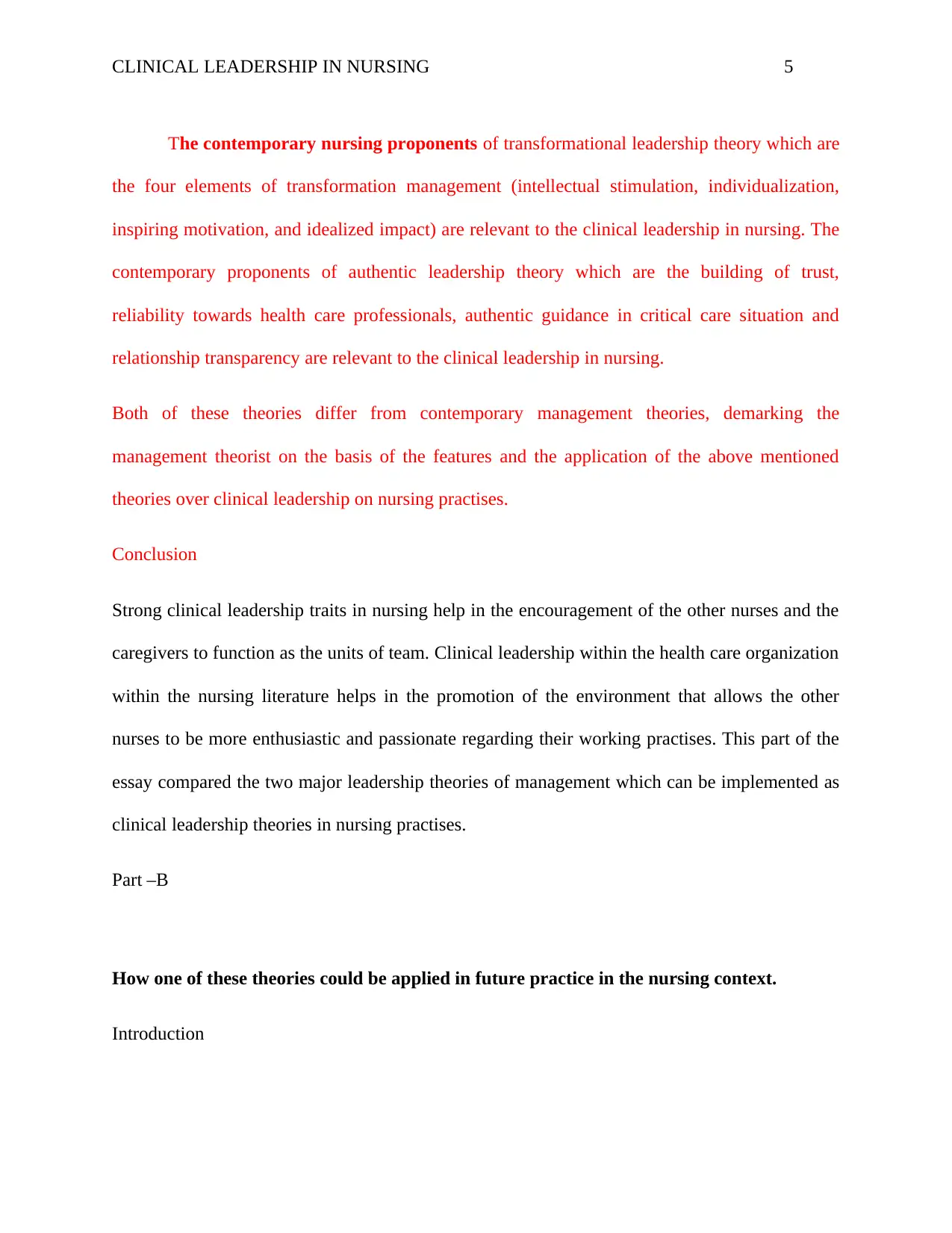
CLINICAL LEADERSHIP IN NURSING 5
The contemporary nursing proponents of transformational leadership theory which are
the four elements of transformation management (intellectual stimulation, individualization,
inspiring motivation, and idealized impact) are relevant to the clinical leadership in nursing. The
contemporary proponents of authentic leadership theory which are the building of trust,
reliability towards health care professionals, authentic guidance in critical care situation and
relationship transparency are relevant to the clinical leadership in nursing.
Both of these theories differ from contemporary management theories, demarking the
management theorist on the basis of the features and the application of the above mentioned
theories over clinical leadership on nursing practises.
Conclusion
Strong clinical leadership traits in nursing help in the encouragement of the other nurses and the
caregivers to function as the units of team. Clinical leadership within the health care organization
within the nursing literature helps in the promotion of the environment that allows the other
nurses to be more enthusiastic and passionate regarding their working practises. This part of the
essay compared the two major leadership theories of management which can be implemented as
clinical leadership theories in nursing practises.
Part –B
How one of these theories could be applied in future practice in the nursing context.
Introduction
The contemporary nursing proponents of transformational leadership theory which are
the four elements of transformation management (intellectual stimulation, individualization,
inspiring motivation, and idealized impact) are relevant to the clinical leadership in nursing. The
contemporary proponents of authentic leadership theory which are the building of trust,
reliability towards health care professionals, authentic guidance in critical care situation and
relationship transparency are relevant to the clinical leadership in nursing.
Both of these theories differ from contemporary management theories, demarking the
management theorist on the basis of the features and the application of the above mentioned
theories over clinical leadership on nursing practises.
Conclusion
Strong clinical leadership traits in nursing help in the encouragement of the other nurses and the
caregivers to function as the units of team. Clinical leadership within the health care organization
within the nursing literature helps in the promotion of the environment that allows the other
nurses to be more enthusiastic and passionate regarding their working practises. This part of the
essay compared the two major leadership theories of management which can be implemented as
clinical leadership theories in nursing practises.
Part –B
How one of these theories could be applied in future practice in the nursing context.
Introduction
⊘ This is a preview!⊘
Do you want full access?
Subscribe today to unlock all pages.

Trusted by 1+ million students worldwide
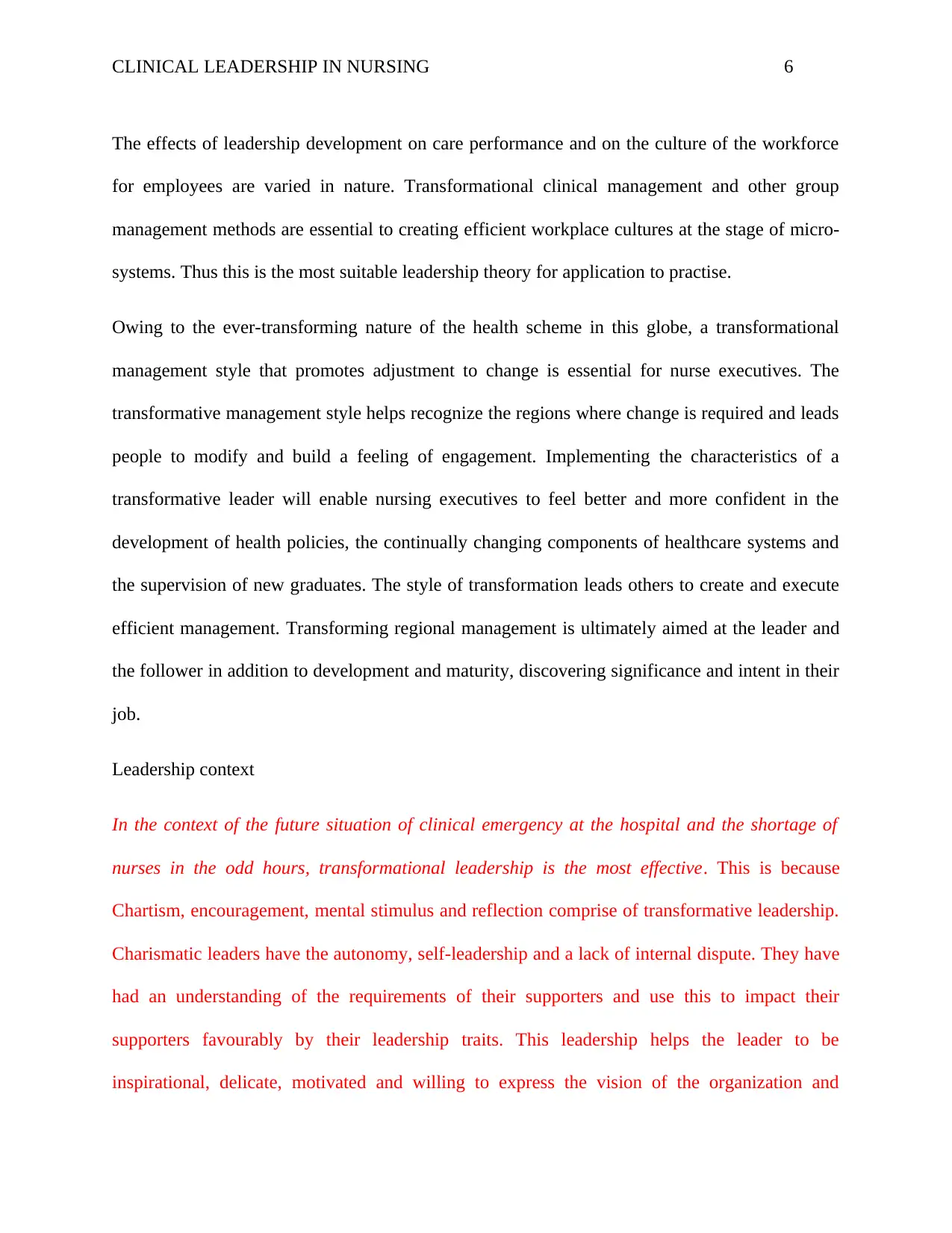
CLINICAL LEADERSHIP IN NURSING 6
The effects of leadership development on care performance and on the culture of the workforce
for employees are varied in nature. Transformational clinical management and other group
management methods are essential to creating efficient workplace cultures at the stage of micro-
systems. Thus this is the most suitable leadership theory for application to practise.
Owing to the ever-transforming nature of the health scheme in this globe, a transformational
management style that promotes adjustment to change is essential for nurse executives. The
transformative management style helps recognize the regions where change is required and leads
people to modify and build a feeling of engagement. Implementing the characteristics of a
transformative leader will enable nursing executives to feel better and more confident in the
development of health policies, the continually changing components of healthcare systems and
the supervision of new graduates. The style of transformation leads others to create and execute
efficient management. Transforming regional management is ultimately aimed at the leader and
the follower in addition to development and maturity, discovering significance and intent in their
job.
Leadership context
In the context of the future situation of clinical emergency at the hospital and the shortage of
nurses in the odd hours, transformational leadership is the most effective. This is because
Chartism, encouragement, mental stimulus and reflection comprise of transformative leadership.
Charismatic leaders have the autonomy, self-leadership and a lack of internal dispute. They have
had an understanding of the requirements of their supporters and use this to impact their
supporters favourably by their leadership traits. This leadership helps the leader to be
inspirational, delicate, motivated and willing to express the vision of the organization and
The effects of leadership development on care performance and on the culture of the workforce
for employees are varied in nature. Transformational clinical management and other group
management methods are essential to creating efficient workplace cultures at the stage of micro-
systems. Thus this is the most suitable leadership theory for application to practise.
Owing to the ever-transforming nature of the health scheme in this globe, a transformational
management style that promotes adjustment to change is essential for nurse executives. The
transformative management style helps recognize the regions where change is required and leads
people to modify and build a feeling of engagement. Implementing the characteristics of a
transformative leader will enable nursing executives to feel better and more confident in the
development of health policies, the continually changing components of healthcare systems and
the supervision of new graduates. The style of transformation leads others to create and execute
efficient management. Transforming regional management is ultimately aimed at the leader and
the follower in addition to development and maturity, discovering significance and intent in their
job.
Leadership context
In the context of the future situation of clinical emergency at the hospital and the shortage of
nurses in the odd hours, transformational leadership is the most effective. This is because
Chartism, encouragement, mental stimulus and reflection comprise of transformative leadership.
Charismatic leaders have the autonomy, self-leadership and a lack of internal dispute. They have
had an understanding of the requirements of their supporters and use this to impact their
supporters favourably by their leadership traits. This leadership helps the leader to be
inspirational, delicate, motivated and willing to express the vision of the organization and
Paraphrase This Document
Need a fresh take? Get an instant paraphrase of this document with our AI Paraphraser

CLINICAL LEADERSHIP IN NURSING 7
promote pride (Asif et al., 2019). Transformational clinical nursing rulers spur other nurses
intellectually by promoting the use of evidence-based practice and by discussing the "why" and
"how" of particular clinical behaviour in case of clinical emergencies and during the shortage of
staffs. A transformational leader's four main features include an efficient communication
provider, exciting features, reliability and teamwork promotion.
Use of the theory
The transformative style of leadership uses various management skills and methods and creates
clear benefits for the organization. A method of leadership used by clinical nursing officials has a
direct impact on the fulfilment of the health care provider, which eventually affects patient
attainment (Crowne et al., 2017). In the context of the above stated scenario, transformational
leadership and its key factors towards the practise of clinical leadership is extremely effective for
clinical emergency and shortage of nurses in odd hours. The leaders will motivate and encourage
the existing nurses to control the situation, appraise their work performances and supports in the
odd hours and inspire them towards commitment to nursing role and high levels of morale.
Some of the implications and the outcomes that could be gained by the use of the
transformational theory in the nursing leadership practise are as follows.
With today's healthcare issues, it is essential that the care sector is in the lead with the healthcare
reform and utterly committed to implementing the improvements in the healthcare system.
The issue of reclassifying the position of nurse chiefs can be one of the leadership scenarios that
may become a future situation. Transformative clinical leadership assists the staff in the right
direction or route (Reichenpfader, Carlfjord & Nilsen, 2015).
promote pride (Asif et al., 2019). Transformational clinical nursing rulers spur other nurses
intellectually by promoting the use of evidence-based practice and by discussing the "why" and
"how" of particular clinical behaviour in case of clinical emergencies and during the shortage of
staffs. A transformational leader's four main features include an efficient communication
provider, exciting features, reliability and teamwork promotion.
Use of the theory
The transformative style of leadership uses various management skills and methods and creates
clear benefits for the organization. A method of leadership used by clinical nursing officials has a
direct impact on the fulfilment of the health care provider, which eventually affects patient
attainment (Crowne et al., 2017). In the context of the above stated scenario, transformational
leadership and its key factors towards the practise of clinical leadership is extremely effective for
clinical emergency and shortage of nurses in odd hours. The leaders will motivate and encourage
the existing nurses to control the situation, appraise their work performances and supports in the
odd hours and inspire them towards commitment to nursing role and high levels of morale.
Some of the implications and the outcomes that could be gained by the use of the
transformational theory in the nursing leadership practise are as follows.
With today's healthcare issues, it is essential that the care sector is in the lead with the healthcare
reform and utterly committed to implementing the improvements in the healthcare system.
The issue of reclassifying the position of nurse chiefs can be one of the leadership scenarios that
may become a future situation. Transformative clinical leadership assists the staff in the right
direction or route (Reichenpfader, Carlfjord & Nilsen, 2015).

CLINICAL LEADERSHIP IN NURSING 8
The functions of the transformational leader in healthcare typically involve encouraging
coordination, promoting good self-esteem, motivating employees to operate at the highest rate of
achievement and empowering ring employees to participate more effectively in policy creation
and execution (McCaffrey & Reinoso, 2017). The transformative leader depicts credibility and
inspires others with an optimistic, favourable and promoting perspective. It is essential to have
transformation leadership, particularly in clinical fields, where there are new graduate staff. The
characteristics of transformative leaders within the clinical leadership encourage a safe
atmosphere for employees and personnel that improves employee fulfilment, maintenance and
patient contentment.
The use of transformational leadership approaches to nursing methods helps to support
practices that enhance nursing and workplace results such as job satisfaction, organizational
commitment, productivity, and turnover, by making use of transformational leadership a vital
element of the American Nurses Credentialing Center (ANCC) (Leggat, Balding & Schiftan,
2015). As a nursing leader, you can pursue your individual style of management, set an instance
and create a favourable and empowering body that promotes nursing excellence.
Supervisor assistance is much supported by transformational leadership in clinical nursing
leadership. Working environment assistance is a significant mediator element, especially from
the manager, which illustrates the connection between transformational management and work
happiness. Engagement in organizations was more critical than fulfilment in work for the safety
of nurses (Frankel & PGCMS, 2019). Transformation leaders encourage their fellow employees
to communicate their perspective and use objectives to inspire them. Underlings are urged to
imagine in fresh respects about the ancient issues and can be seen separately. In addition,
The functions of the transformational leader in healthcare typically involve encouraging
coordination, promoting good self-esteem, motivating employees to operate at the highest rate of
achievement and empowering ring employees to participate more effectively in policy creation
and execution (McCaffrey & Reinoso, 2017). The transformative leader depicts credibility and
inspires others with an optimistic, favourable and promoting perspective. It is essential to have
transformation leadership, particularly in clinical fields, where there are new graduate staff. The
characteristics of transformative leaders within the clinical leadership encourage a safe
atmosphere for employees and personnel that improves employee fulfilment, maintenance and
patient contentment.
The use of transformational leadership approaches to nursing methods helps to support
practices that enhance nursing and workplace results such as job satisfaction, organizational
commitment, productivity, and turnover, by making use of transformational leadership a vital
element of the American Nurses Credentialing Center (ANCC) (Leggat, Balding & Schiftan,
2015). As a nursing leader, you can pursue your individual style of management, set an instance
and create a favourable and empowering body that promotes nursing excellence.
Supervisor assistance is much supported by transformational leadership in clinical nursing
leadership. Working environment assistance is a significant mediator element, especially from
the manager, which illustrates the connection between transformational management and work
happiness. Engagement in organizations was more critical than fulfilment in work for the safety
of nurses (Frankel & PGCMS, 2019). Transformation leaders encourage their fellow employees
to communicate their perspective and use objectives to inspire them. Underlings are urged to
imagine in fresh respects about the ancient issues and can be seen separately. In addition,
⊘ This is a preview!⊘
Do you want full access?
Subscribe today to unlock all pages.

Trusted by 1+ million students worldwide
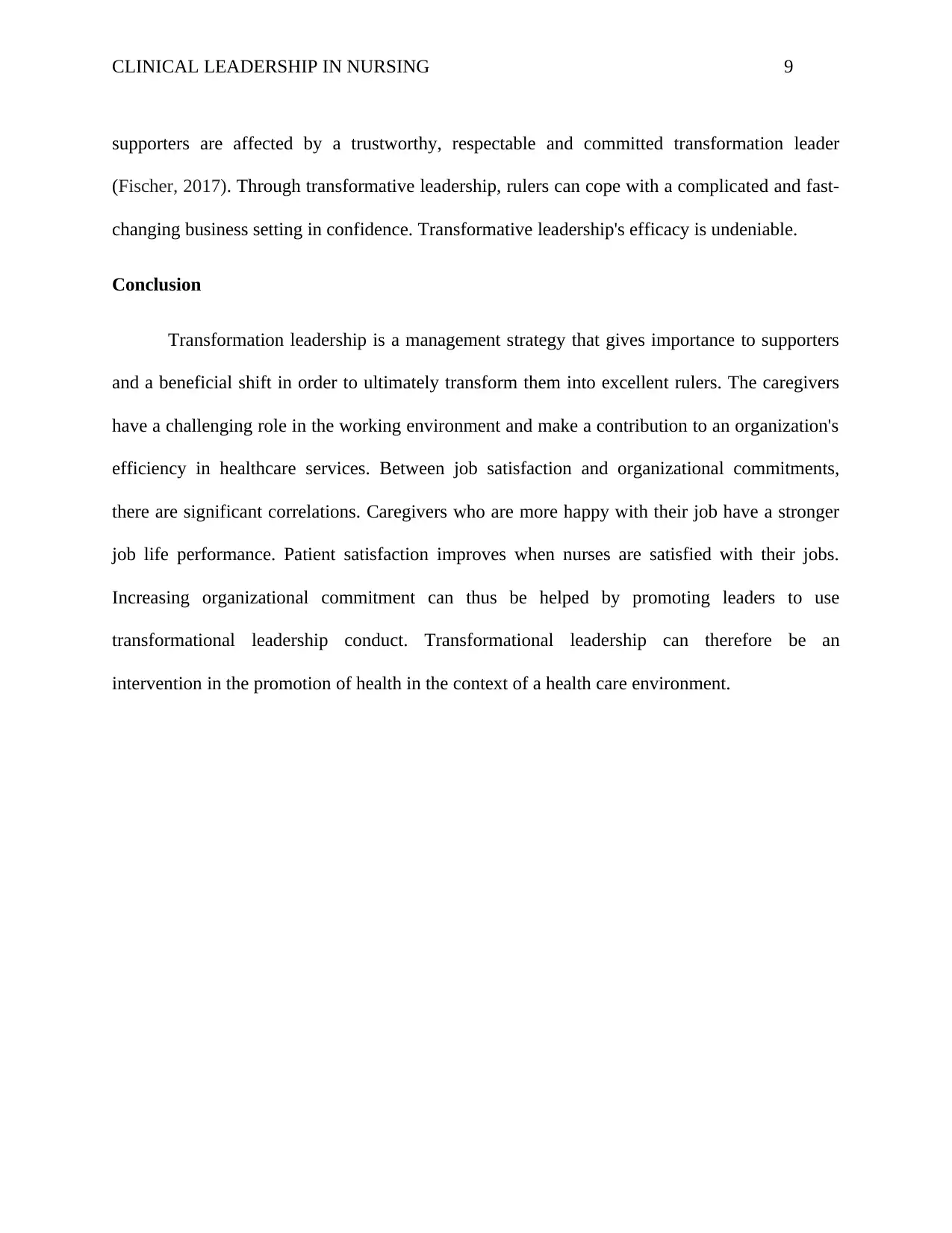
CLINICAL LEADERSHIP IN NURSING 9
supporters are affected by a trustworthy, respectable and committed transformation leader
(Fischer, 2017). Through transformative leadership, rulers can cope with a complicated and fast-
changing business setting in confidence. Transformative leadership's efficacy is undeniable.
Conclusion
Transformation leadership is a management strategy that gives importance to supporters
and a beneficial shift in order to ultimately transform them into excellent rulers. The caregivers
have a challenging role in the working environment and make a contribution to an organization's
efficiency in healthcare services. Between job satisfaction and organizational commitments,
there are significant correlations. Caregivers who are more happy with their job have a stronger
job life performance. Patient satisfaction improves when nurses are satisfied with their jobs.
Increasing organizational commitment can thus be helped by promoting leaders to use
transformational leadership conduct. Transformational leadership can therefore be an
intervention in the promotion of health in the context of a health care environment.
supporters are affected by a trustworthy, respectable and committed transformation leader
(Fischer, 2017). Through transformative leadership, rulers can cope with a complicated and fast-
changing business setting in confidence. Transformative leadership's efficacy is undeniable.
Conclusion
Transformation leadership is a management strategy that gives importance to supporters
and a beneficial shift in order to ultimately transform them into excellent rulers. The caregivers
have a challenging role in the working environment and make a contribution to an organization's
efficiency in healthcare services. Between job satisfaction and organizational commitments,
there are significant correlations. Caregivers who are more happy with their job have a stronger
job life performance. Patient satisfaction improves when nurses are satisfied with their jobs.
Increasing organizational commitment can thus be helped by promoting leaders to use
transformational leadership conduct. Transformational leadership can therefore be an
intervention in the promotion of health in the context of a health care environment.
Paraphrase This Document
Need a fresh take? Get an instant paraphrase of this document with our AI Paraphraser
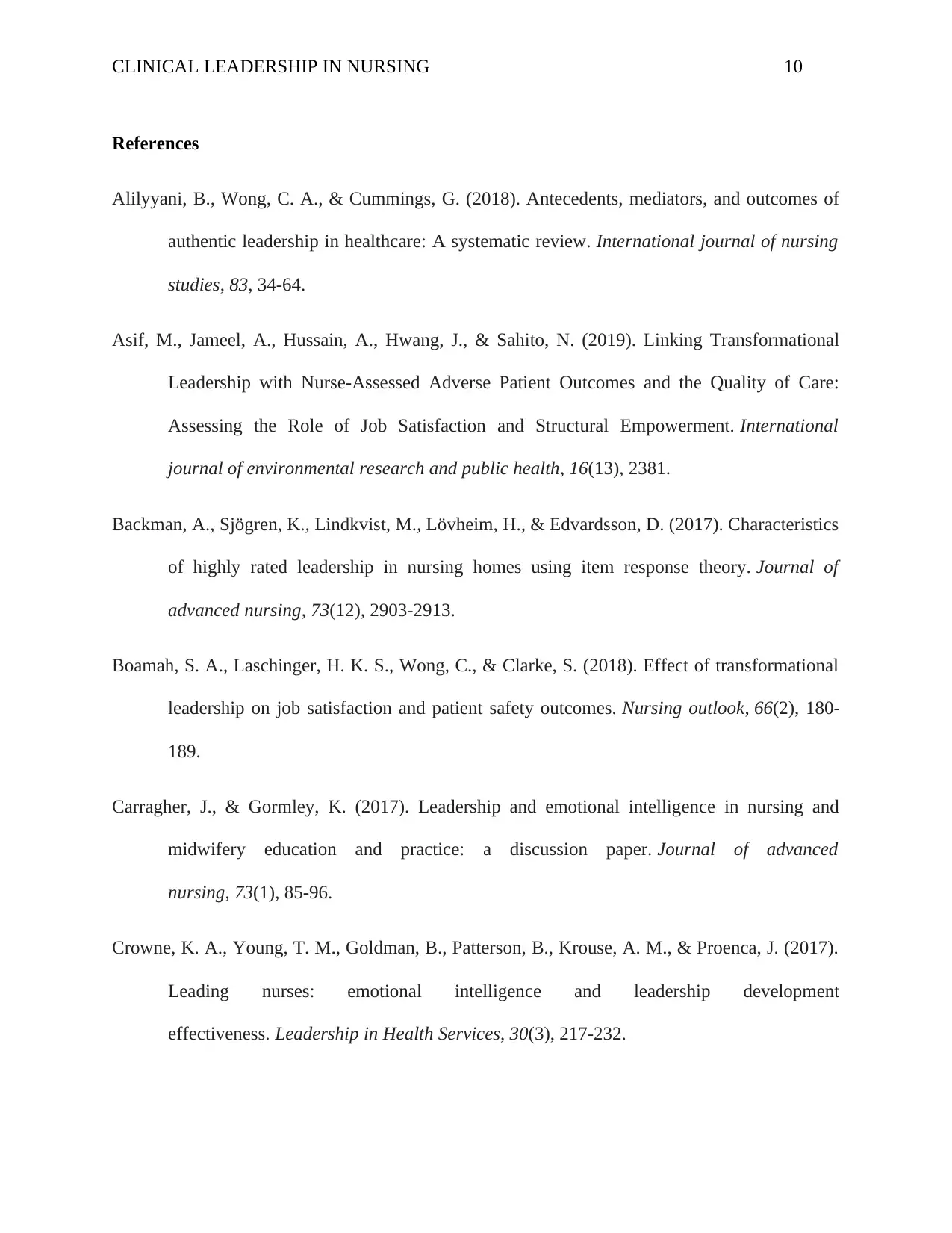
CLINICAL LEADERSHIP IN NURSING 10
References
Alilyyani, B., Wong, C. A., & Cummings, G. (2018). Antecedents, mediators, and outcomes of
authentic leadership in healthcare: A systematic review. International journal of nursing
studies, 83, 34-64.
Asif, M., Jameel, A., Hussain, A., Hwang, J., & Sahito, N. (2019). Linking Transformational
Leadership with Nurse-Assessed Adverse Patient Outcomes and the Quality of Care:
Assessing the Role of Job Satisfaction and Structural Empowerment. International
journal of environmental research and public health, 16(13), 2381.
Backman, A., Sjögren, K., Lindkvist, M., Lövheim, H., & Edvardsson, D. (2017). Characteristics
of highly rated leadership in nursing homes using item response theory. Journal of
advanced nursing, 73(12), 2903-2913.
Boamah, S. A., Laschinger, H. K. S., Wong, C., & Clarke, S. (2018). Effect of transformational
leadership on job satisfaction and patient safety outcomes. Nursing outlook, 66(2), 180-
189.
Carragher, J., & Gormley, K. (2017). Leadership and emotional intelligence in nursing and
midwifery education and practice: a discussion paper. Journal of advanced
nursing, 73(1), 85-96.
Crowne, K. A., Young, T. M., Goldman, B., Patterson, B., Krouse, A. M., & Proenca, J. (2017).
Leading nurses: emotional intelligence and leadership development
effectiveness. Leadership in Health Services, 30(3), 217-232.
References
Alilyyani, B., Wong, C. A., & Cummings, G. (2018). Antecedents, mediators, and outcomes of
authentic leadership in healthcare: A systematic review. International journal of nursing
studies, 83, 34-64.
Asif, M., Jameel, A., Hussain, A., Hwang, J., & Sahito, N. (2019). Linking Transformational
Leadership with Nurse-Assessed Adverse Patient Outcomes and the Quality of Care:
Assessing the Role of Job Satisfaction and Structural Empowerment. International
journal of environmental research and public health, 16(13), 2381.
Backman, A., Sjögren, K., Lindkvist, M., Lövheim, H., & Edvardsson, D. (2017). Characteristics
of highly rated leadership in nursing homes using item response theory. Journal of
advanced nursing, 73(12), 2903-2913.
Boamah, S. A., Laschinger, H. K. S., Wong, C., & Clarke, S. (2018). Effect of transformational
leadership on job satisfaction and patient safety outcomes. Nursing outlook, 66(2), 180-
189.
Carragher, J., & Gormley, K. (2017). Leadership and emotional intelligence in nursing and
midwifery education and practice: a discussion paper. Journal of advanced
nursing, 73(1), 85-96.
Crowne, K. A., Young, T. M., Goldman, B., Patterson, B., Krouse, A. M., & Proenca, J. (2017).
Leading nurses: emotional intelligence and leadership development
effectiveness. Leadership in Health Services, 30(3), 217-232.

CLINICAL LEADERSHIP IN NURSING 11
Cummings, G. G., Tate, K., Lee, S., Wong, C. A., Paananen, T., Micaroni, S. P., & Chatterjee,
G. E. (2018). Leadership styles and outcome patterns for the nursing workforce and work
environment: A systematic review. International Journal of Nursing Studies, 85, 19-60.
Ennis, G., Happell, B., & Reid‐Searl, K. (2015). Clinical leadership in mental health nursing:
The importance of a calm and confident approach. Perspectives in Psychiatric
Care, 51(1), 57-62.
Fischer, S. A. (2017). Transformational leadership in nursing education: Making the
case. Nursing science quarterly, 30(2), 124-128.
Frankel, A., & PGCMS, R. (2019). What leadership styles should senior nurses
develop?. Hospital, 6, 08.
Grossman, S., & Valiga, T. M. (2016). The new leadership challenge: Creating the future of
nursing. FA Davis.
Higgins, E. A. (2015). The influence of nurse manager transformational leadership on nurse and
patient outcomes: mediating effects of supportive practice environments, organizational
citizenship behaviours, patient safety culture and nurse job satisfaction.
Jonas, S., McCay, L., & Keogh, B. (2010). The importance of clinical leadership. ABC of
clinical leadership, 165.
Lavoie‐Tremblay, M., Fernet, C., Lavigne, G. L., & Austin, S. (2016). Transformational and
abusive leadership practices: impacts on novice nurses, quality of care and intention to
leave. Journal of advanced nursing, 72(3), 582-592.
Cummings, G. G., Tate, K., Lee, S., Wong, C. A., Paananen, T., Micaroni, S. P., & Chatterjee,
G. E. (2018). Leadership styles and outcome patterns for the nursing workforce and work
environment: A systematic review. International Journal of Nursing Studies, 85, 19-60.
Ennis, G., Happell, B., & Reid‐Searl, K. (2015). Clinical leadership in mental health nursing:
The importance of a calm and confident approach. Perspectives in Psychiatric
Care, 51(1), 57-62.
Fischer, S. A. (2017). Transformational leadership in nursing education: Making the
case. Nursing science quarterly, 30(2), 124-128.
Frankel, A., & PGCMS, R. (2019). What leadership styles should senior nurses
develop?. Hospital, 6, 08.
Grossman, S., & Valiga, T. M. (2016). The new leadership challenge: Creating the future of
nursing. FA Davis.
Higgins, E. A. (2015). The influence of nurse manager transformational leadership on nurse and
patient outcomes: mediating effects of supportive practice environments, organizational
citizenship behaviours, patient safety culture and nurse job satisfaction.
Jonas, S., McCay, L., & Keogh, B. (2010). The importance of clinical leadership. ABC of
clinical leadership, 165.
Lavoie‐Tremblay, M., Fernet, C., Lavigne, G. L., & Austin, S. (2016). Transformational and
abusive leadership practices: impacts on novice nurses, quality of care and intention to
leave. Journal of advanced nursing, 72(3), 582-592.
⊘ This is a preview!⊘
Do you want full access?
Subscribe today to unlock all pages.

Trusted by 1+ million students worldwide
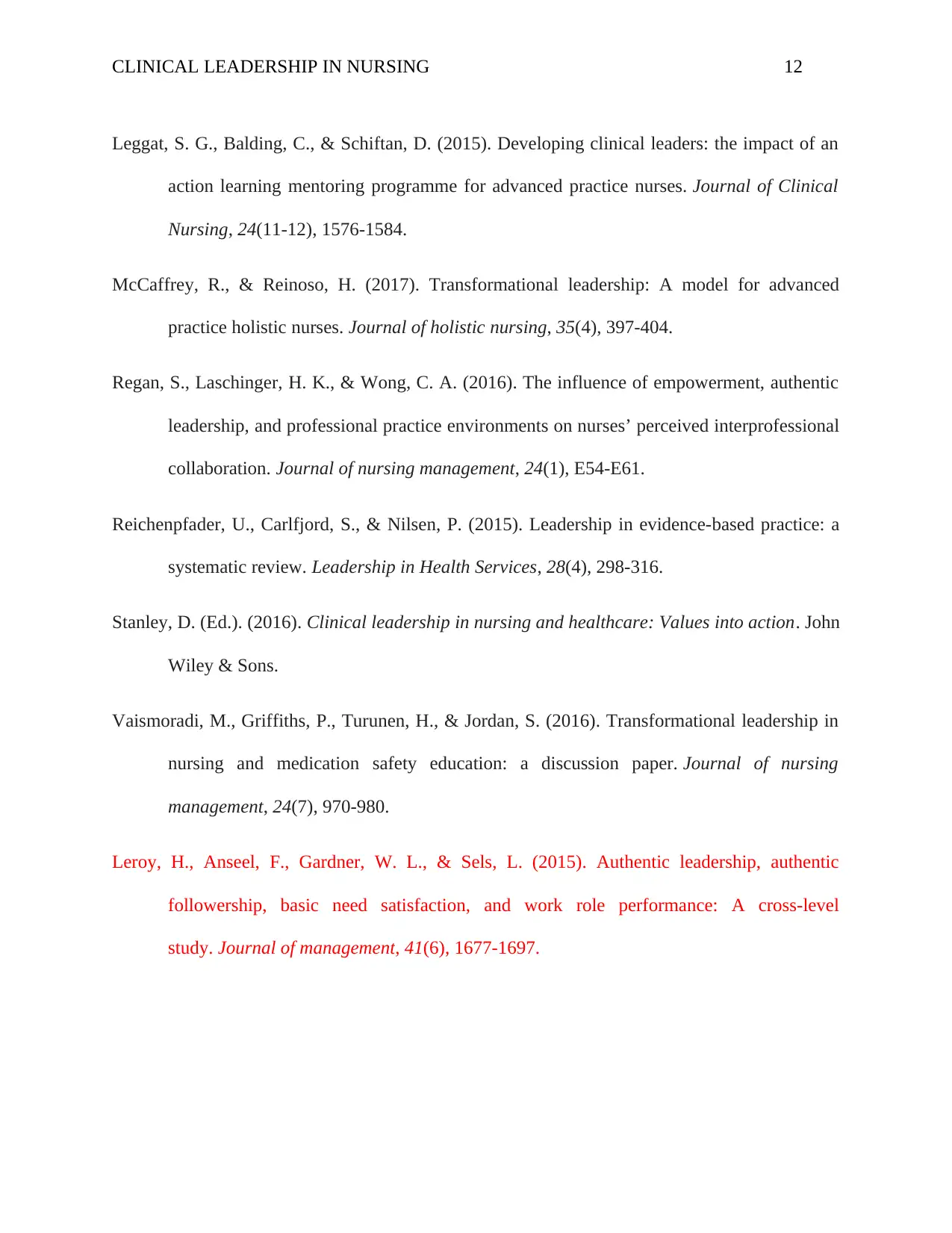
CLINICAL LEADERSHIP IN NURSING 12
Leggat, S. G., Balding, C., & Schiftan, D. (2015). Developing clinical leaders: the impact of an
action learning mentoring programme for advanced practice nurses. Journal of Clinical
Nursing, 24(11-12), 1576-1584.
McCaffrey, R., & Reinoso, H. (2017). Transformational leadership: A model for advanced
practice holistic nurses. Journal of holistic nursing, 35(4), 397-404.
Regan, S., Laschinger, H. K., & Wong, C. A. (2016). The influence of empowerment, authentic
leadership, and professional practice environments on nurses’ perceived interprofessional
collaboration. Journal of nursing management, 24(1), E54-E61.
Reichenpfader, U., Carlfjord, S., & Nilsen, P. (2015). Leadership in evidence-based practice: a
systematic review. Leadership in Health Services, 28(4), 298-316.
Stanley, D. (Ed.). (2016). Clinical leadership in nursing and healthcare: Values into action. John
Wiley & Sons.
Vaismoradi, M., Griffiths, P., Turunen, H., & Jordan, S. (2016). Transformational leadership in
nursing and medication safety education: a discussion paper. Journal of nursing
management, 24(7), 970-980.
Leroy, H., Anseel, F., Gardner, W. L., & Sels, L. (2015). Authentic leadership, authentic
followership, basic need satisfaction, and work role performance: A cross-level
study. Journal of management, 41(6), 1677-1697.
Leggat, S. G., Balding, C., & Schiftan, D. (2015). Developing clinical leaders: the impact of an
action learning mentoring programme for advanced practice nurses. Journal of Clinical
Nursing, 24(11-12), 1576-1584.
McCaffrey, R., & Reinoso, H. (2017). Transformational leadership: A model for advanced
practice holistic nurses. Journal of holistic nursing, 35(4), 397-404.
Regan, S., Laschinger, H. K., & Wong, C. A. (2016). The influence of empowerment, authentic
leadership, and professional practice environments on nurses’ perceived interprofessional
collaboration. Journal of nursing management, 24(1), E54-E61.
Reichenpfader, U., Carlfjord, S., & Nilsen, P. (2015). Leadership in evidence-based practice: a
systematic review. Leadership in Health Services, 28(4), 298-316.
Stanley, D. (Ed.). (2016). Clinical leadership in nursing and healthcare: Values into action. John
Wiley & Sons.
Vaismoradi, M., Griffiths, P., Turunen, H., & Jordan, S. (2016). Transformational leadership in
nursing and medication safety education: a discussion paper. Journal of nursing
management, 24(7), 970-980.
Leroy, H., Anseel, F., Gardner, W. L., & Sels, L. (2015). Authentic leadership, authentic
followership, basic need satisfaction, and work role performance: A cross-level
study. Journal of management, 41(6), 1677-1697.
1 out of 13
Related Documents
Your All-in-One AI-Powered Toolkit for Academic Success.
+13062052269
info@desklib.com
Available 24*7 on WhatsApp / Email
![[object Object]](/_next/static/media/star-bottom.7253800d.svg)
Unlock your academic potential
© 2024 | Zucol Services PVT LTD | All rights reserved.





